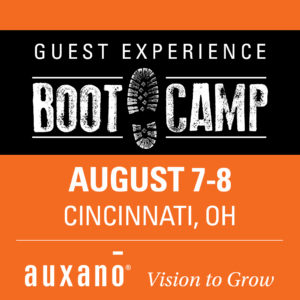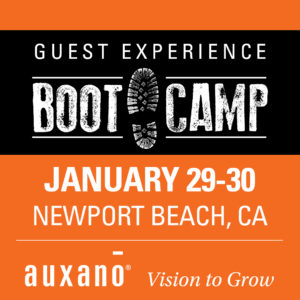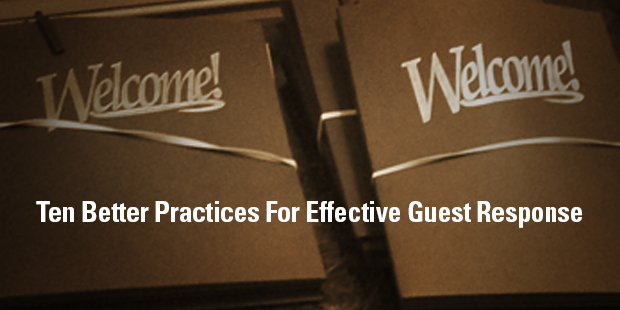The dining experience at a four-star restaurant provides excellent lessons for hospitality in the church.
With one son who is the general manager of a restaurant that is part of a national restaurant chain and another who is the food services manager for a conference center, I have a serious interest in all things food. My waistline also shows that, but that’s another story.
During a visit to my older son’s house I was perusing his bookshelf and took a look at “On the Line“, about the famous New York restaurant Le Bernardin and Executive Chef Eric Ripert. It’s a well-written and beautifully photographed look at the inner workings of the world-famous restaurant.
It’s also full of great lessons for churches that want to have world-class Guest Experiences.
Your church will not be serving exquisite meals that diners pay big bucks for – but your church can learn that the meal is only a part of the total dining experience which is EXCEPTIONAL.
Want to learn how to create an EXCEPTIONAL Guest Experience at your church? Check out Auxano’s Guest Experience Boot Camp, coming to Orlando, FL on April 3-4.
The Dining Experience
One of the things that diners remark upon after eating at Le Bernardin is that the service is almost invisible. By the end of the meal, you’ve been helped by as many as seven people, but you can’t quite identify them. Although friendly and available, they work out of your field of attention so that you can focus on the food, and companions, in front of you.
While it might seem effortless, it’s a rigorous ballet that requires training and focus. The men and women juggle a plethora of details in their heads while projecting an air of gracious calm.
We have to perform to give you an illusion of effortless perfection. For you to have the right food in front of you at the right time, excellent and at the right temperature, and obviously having clean china – all those little details you’d never think of are vital
– Eric Ripert
THE QUICK SUMMARY – On the Line, by Eric Ripert
Take one top New York restaurant, add danger, drama, and dialogue, toss in their best recipes, and you have a cooking classic.
How does a 4-star restaurant stay on top for more than two decades? In On the Line, chef Eric Ripert takes readers behind the scenes at Le Bernardin, one of just three New York City restaurants to earn three Michelin stars. Any fan of gourmet dining who ever stole a peek behind a restaurant kitchen’s swinging doors will love this unique insider’s account, with its interviews, inventory checklists, and fly-on-the-wall dialogue that bring the business of haute cuisine to life.
From the sudden death of Le Bernardin’s founding chef, Gilbert Le Coze, to Ripert’s stressful but triumphant takeover of the kitchen at age 29, the story has plenty of drama. But as Chef Ripert and writer Christine Muhlke reveal, every day is an adventure in a perfectionistic restaurant kitchen. Foodies will love reading about the inner workings of a top restaurant, from how a kitchen is organized to the real cost of the food and the fierce discipline and organization it takes to achieve culinary perfection on the plate almost 150,000 times a year.
A SIMPLE SOLUTION
The most visible part of a dining experience is the food placed on the table in front of the diner. However, that meal represents many people doing many different tasks, some hours ahead of the mealtime.
Excellence happens best when it’s not seen at all. Your meal should be relaxed and gracious, but it’s hard to imagine the military precision with which the dining room is run.
Excellence doesn’t happen by accident but instead is the result of a series of intentional elements of service.
The center of attention in a four-star restaurant may be the food, but it’s the service before, during, and after that creates the experience.
At Le Bernardin in New York City, the service is as much the creation of Executive Chef Eric Ripert as is his exquisite dishes. Along with the restaurant’s founder Maguy Le Coze, Ripert has created the elements of service that keep Le Bernardin at the top of its class.
Hiring– while they prefer staff with a two- or three- star background, they have been known to go with their gut instinct and hire the people they like, those that have the demeanor and willingness to please.
Training– the standard of perseverance and constant training is set at the top and carried throughout the organization. General manager David Mancini and Maître d’ Ben Chekroun want each hire to know what goes into every other job on the floor. The constant cross training that goes on enables the entire staff from the captains to the busboys to operate in a seamless, fluid manner.
Knowledge– The level of service expected by customers at Le Bernardin is matched and exceeded by the knowledge the staff constantly pursues. From the technical side (knowing the menu by heart, how each serving is prepared, the correct place settings, etc.) to the human aspect (learning to watch guests for clues, anticipating their needs), the staff is always learning.
Attitude– over the years the atmosphere has become less formal, but Le Bernardin’s staff will provide what you are looking for: to celebrate, to eat, to do business, to entertain the family. Their goal is for you to enjoy the experience and leave happy with a smile.
The Sixth Sense– Chekroun says that the ability to read a guest is the key to providing four-star service. “You can tell if someone is used to a four-star restaurant or it’s their first time. It’s our job to put them at ease no matter the situation. Intuition is very important on the floor – before a guest can ask “Where’s my waiter?” you must be there.”
Teamwork– At Le Bernardin, service is like the proverbial chain – a weak link will compromise the whole thing. Anyone on the chain, from the time you make a reservation till the moment you leave, can ruin the experience. It’s all about functioning as a team; even though the service is broken into sections, that’s merely strategic. The entire team is expected to understand the ebb and flow of the service and step in before needed.
Presentation– The hallmark of the food at Le Bernardin is the exquisite simplicity of the food, which calls for adding the final touch at the table. The sauces for the meal are served at the table, which provides several advantages: warmer service, better flavors, and eye-catching presentations.
Eric Ripert, On The Line
A NEXT STEP
Let’s step away from the elegance of Le Bernardin and visit your church. Is it too big a jump to imagine that your hospitality needs to have the same elements of service as a four-star restaurant?
List the seven elements of service noted above, each on a chart tablet page.
After reading the description for each one, brainstorm with your team how that element of service applies to your hospitality ministry.
For each of the seven elements, write one or more actions that your hospitality teams are currently doing that are working well. Ask the question “Is this good enough, or can we do better?” List the responses on the appropriate page.
Now go back to the seven elements, this time looking for areas that are either a total miss or sorely lacking. Ask the question “How can we make this better?” List the responses on the appropriate page.
Finally, review all of the actions you have listed. Circle the top three your team wants to pursue in each category, and assign responsibility and timelines for each.
In ninety days, reconvene your team, bring out the chart tablets, and update progress and results for each of the actions circled.
Excerpt taken from SUMS Remix 73-2, issued August 2017.
This is part of a weekly series posting excerpts from one of the most innovative content sources in the church world: SUMS Remix Book Summaries for church leaders.
SUMS Remix takes a practical problem in the church and looks at it with three solutions; each solution is taken from a different book. Additionally, a practical action step is included with each solution.
As a church leader you get to scan relevant books based on practical tools and solutions to real ministry problems, not just by the cover of the book. Each post will have the edition number which shows the year and what number it is in the overall sequence. (SUMS Remix provides 26 issues per year, delivered every other week to your inbox).
>> Subscribe to SUMS Remix <<
Check out Auxano’s Guest Experience Boot Camp, coming to Cincinnati, OH on August 7-8.


Tags: Guest Experience, Guest Experience Boot Camp, SUMS Remix
|
What is MyVisionRoom? > | Back to Execution >




































